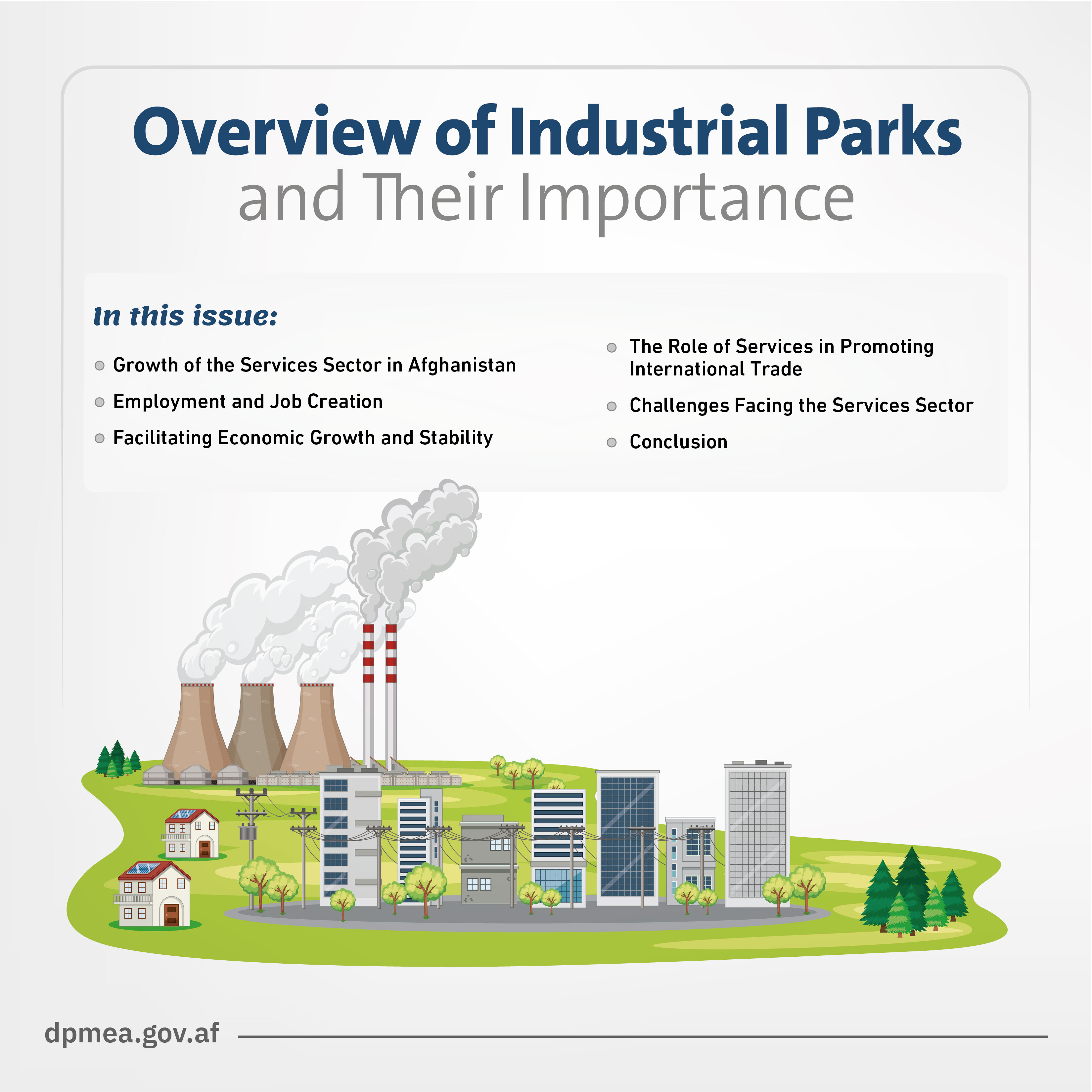Overview of Industrial Parks and Their Importance

Author: Abdullah
Introduction
Industry plays a significant role in human life, not only meeting most of our daily needs but also being a critical factor in the economic development of countries. Unfortunately, the contribution of industry in Afghanistan has not been very substantial. The industrial sector has never had the opportunity to play the role it should have in Afghanistan’s growth and development. The various economic systems and policies Afghanistan has experienced over the past few decades have not been able to support the growth of this sector, and the challenges faced by industrialists still persist. As a result, the country’s industries remain limited to basic and consumer goods production.
The role of industry in modern society is multifaceted and is essential for economic growth, technological advancement, and job creation. Industry contributes significantly to the Gross Domestic Product (GDP) and fosters economic development. Manufacturing, construction, and services generate wealth and improve living standards. Industries also provide millions of jobs worldwide and offer employment opportunities in various fields, which is crucial for reducing unemployment and supporting local economies.
Although Afghanistan has a historical background in industry, foreign invasions and the lack of sustainable governance have prevented long-term government plans and programs from being fully implemented. In modern times, the existence of infrastructure for industrial production has been extremely important. Previous governments and regimes, recognizing this need, laid the foundation for industrial parks in several provinces, some of which were completed, while others remain unfinished. Industrial parks are vital for manufacturing and factories, and in this review, we will briefly examine the status of industrial parks in Afghanistan.
Industrial Parks and Their Importance
Industrial parks in Afghanistan are part of the economic zones designed and constructed according to strategic urban plans for economic development. These parks are equipped with necessary infrastructure and are used for manufacturing and industrial activities. In essence, industrial parks provide a suitable environment for the growth of industry and industrial activities in a country, serving as a hub for industries and attracting investment.
Industrial parks are among the economic zones designed to promote economic growth and development according to urban strategic plans. They have essential infrastructure such as internal roads, connections to highways, electricity networks, water supply systems, wastewater drainage systems, communication systems, and facilities that meet the needs of industrialists. These facilities are utilized by factory owners. There are three main types of industrial parks: public industrial parks, public-private partnership parks, and private industrial parks.
Public Industrial Parks: These parks are created and managed by the government or state-owned companies. They are built and managed according to the strategic plans of cities.
Public-Private Partnership Industrial Parks: These parks are established, operated, and managed through public-private partnerships.
Private Industrial Parks: These parks are built by the private sector on privately owned land based on permits from the Afghanistan Industrial Zones Regulatory Authority and in compliance with industrial park regulations. Their activities and adherence to national laws and regulations are monitored.
Industrial Parks in Afghanistan
Organized industrial activities began for the first time in 1974 with the creation of the first industrial park in the Pul-e-Charkhi area of Kabul. Later, the Bagrami industrial park in Kabul and another park in Herat province were established. The construction of industrial parks across the country is one of the government’s practical measures to promote industry, attract investment, and create job opportunities in Afghanistan. According to officials from the Ministry of Industry and Commerce, 26 new industrial parks are planned to be established in various provinces to meet the country's industrial needs.
As of 2023, 39 industrial parks have been proposed, with nine of these parks planned in the provinces of Takhar, Badakhshan, Daikundi, Sar-e Pol, Laghman, Ghazni, Baghlan, and Samangan. According to the Ministry of Industry and Commerce, new industrial parks will also be established in the provinces of Balkh, Herat, Khost, Bamyan, Laghman, Nimroz, Daikundi, Kunduz, Farah, Kandahar, Takhar, Jawzjan, Baghlan, and Ghazni. Currently, the construction of several industrial parks, including those in Baghlan, Kunduz, Takhar, and Badakhshan, is underway. According to the Ministry of Industry and Commerce spokesperson, the infrastructure of these parks is being built with government funds, and the private sector will invest in production and industry.
Conclusion
Industrial parks are one of the fundamental needs of the industrial sector in Afghanistan. Although the country has dozens of industrial parks, attention to infrastructure and other amenities is a key factor for these production sites, which should be prioritized. By increasing the level of facilities in industrial parks, the basic needs of industrialists will be met, attracting more domestic and even foreign investment. The Islamic Emirate must pay closer attention to this matter. Imported electricity cannot solve the country's long-term problems, so the construction of large power plants in the country should be a priority. While addressing this issue, the government should increase imported electricity and allocate a significant portion to the private sector to address industrialists' problems. Additionally, solar and gas-generated electricity production should be increased to meet the electricity needs of the industrial sector. The Islamic Emirate is working to address the shortage of electricity by increasing domestic electricity production, and practical efforts to produce tens of megawatts of solar power are underway, with plans to produce 100 megawatts of gas-powered electricity in the near future. If investment opportunities are provided and industrialists’ problems are addressed promptly, it is not far-fetched to imagine Afghanistan achieving self-sufficiency in many production sectors, thereby preventing the outflow of large sums of money that are currently spent on importing these goods.